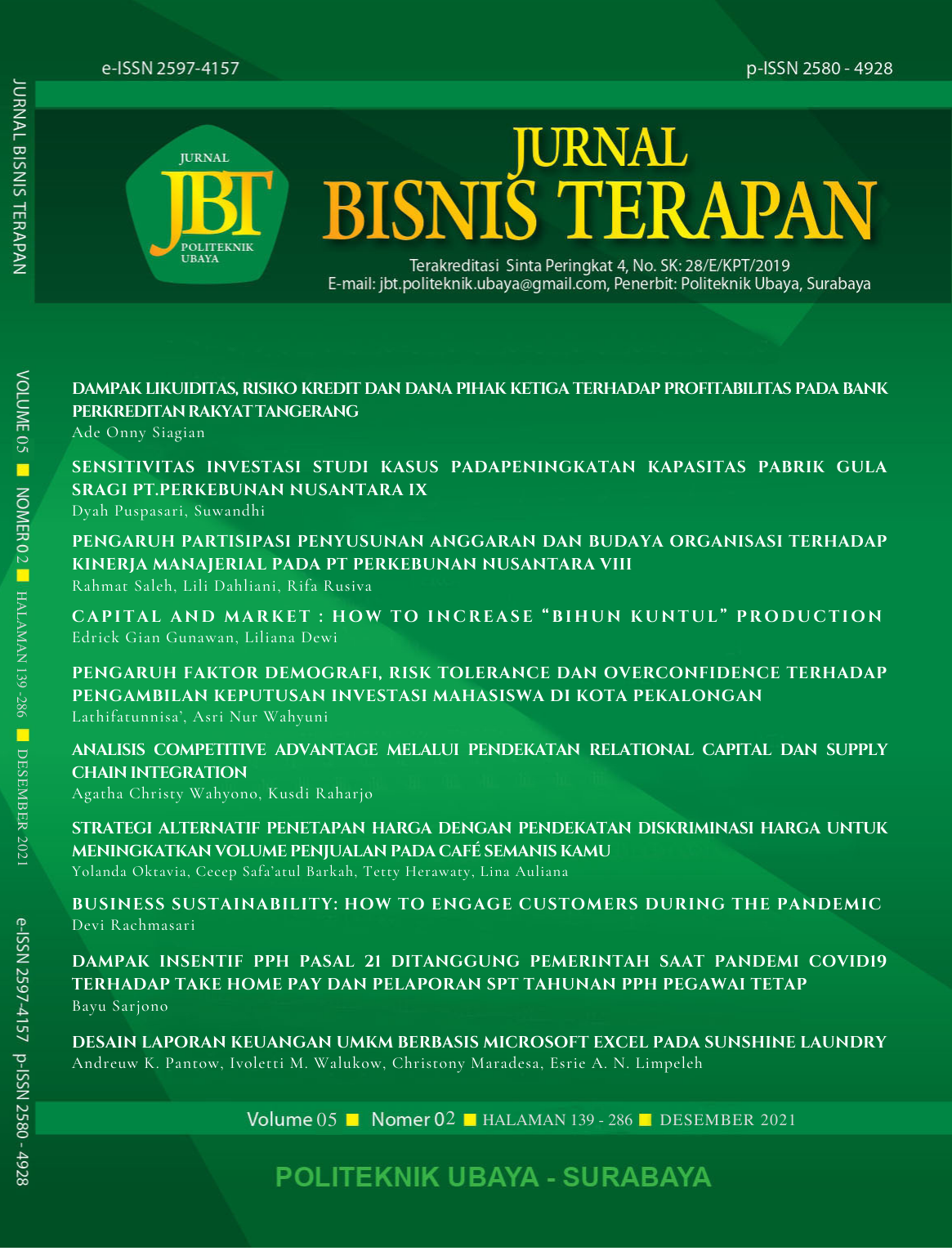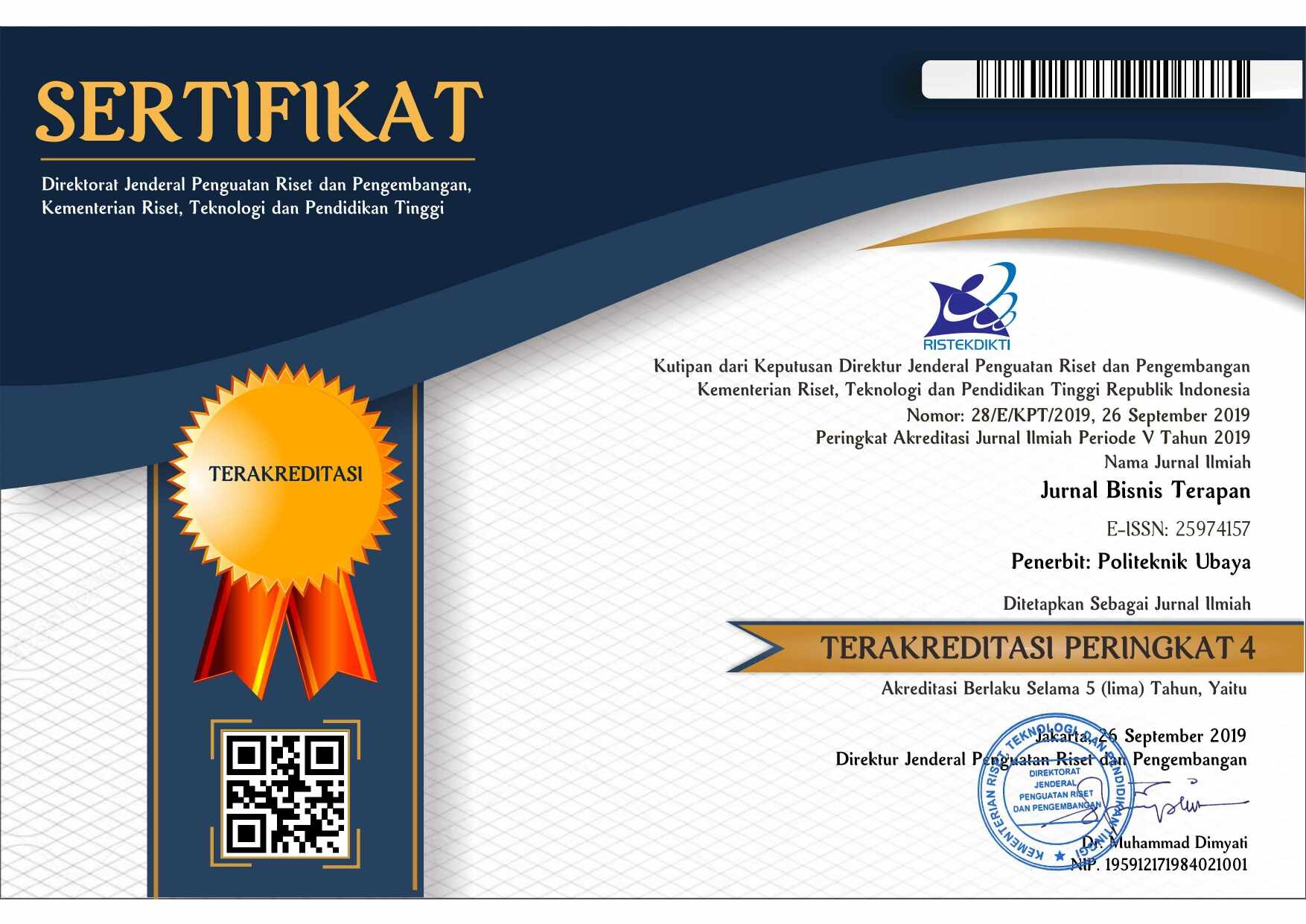DESAIN LAPORAN KEUANGAN UMKM BERBASIS MICROSOFT EXCEL PADA SUNSHINE LAUNDRY
 Abstract Views:
1896 times
Abstract Views:
1896 times
 PDF Downloads:
1965 times
PDF Downloads:
1965 times
Abstract
This study aims to design the financial statements of Sunshine Laundry using the Microsoft Excel application. The research method was descriptive qualitative. Instruments of data collection was down through interview in the form of questions regarding the recording of financial statements. While the data collection instrument with documentation, was done through namely evidence of transactions that occurred in the business. The results of this study indicate that the design of financial statements with Microsoft Excel helps Sunshine Laundry in compiling financial reports in accordance with EMKM accounting standards. The design of financial reports using Microsoft Excel is assisted by data flow diagrams to describe the flow of the system consisting of a menu design sheet, module 1, module 2, price list, transaction list, account type, chart of account, general journal, income statement, and statement of financial position.
Downloads
References
Aditya, R., & Wardhana, A. (2016). Pengaruh perceived usefulness dan perceived ease of use terhadap behavioral intention dengan pendekatan Technology Acceptance Model (TAM) pada pengguna Instant Messaging LINE di Indonesia. Jurnal Siasat Bisnis, 20(1), 24–32. https://doi.org/10.20885/jsb.vol20.iss1.art3
Andarsari, P. R., & Dura, J. (2018). IMPLEMENTASI PENCATATAN KEUANGAN PADA USAHA KECIL DAN MENENGAH. Jurnal Ilmiah Bisnis Dan Ekonomi Asia. https://doi.org/10.32812/jibeka.v12i1.16
Bedard, J. C., Jackson, C., Ettredge, M. L., & Johnstone, K. M. (2003). The effect of training on auditors’ acceptance of an electronic work system. International Journal of Accounting Information Systems, 4(4), 227–250. https://doi.org/10.1016/j.accinf.2003.05.001
Carey, P. (2015). External Accountants’ Busi- ness Advice and SME Performance. Pacific Accounting Review, 27(2). https://doi.org/10.1108/PAR-04- 2013-0020
Coram, P. J. (2018). Discussion of: Accounting practitioners’ attitudes toward accounting harmonization: Adoption of ifrs for smes in italy. Journal of International Accounting Research. https://doi.org/10.2308/jiar-10630
Darmaningtyas, I. G. B., & Suardana, K. A. (2017). Pengaruh Technology Acceptance Model (TAM) dalam Penggunaan Software oleh Auditor yang Berimplikasi pada Kinerja Auditor. E-Jurnal Akuntansi, 21, 2448–2478. https://doi.org/10.24843/EJA.2017.v21.i03.p27
Daspit, J. J., & D’Souza, D. E. (2017). Capability Configuration in Software Industry SMEs: The CAO Model of Ordinary Capabilities. In Journal of Small Business Management. https://doi.org/10.1111/jsbm.12330
Hasan, A., & Gusnardi. (2018). Prospek Implementasi Standar Akuntansi : Entitas Mikro, Kecil, dan Menengah Berbasis Kualitas Laporan Keuangan yang Berlaku Efektif per 1 Januari 2018. The Sadari Institute (SADARIPRESS).
Indriantoro, N., & Supomo, B. (2016). Metode Penelitian Bisnis untuk Akuntansi & Manajemen. In EKONOMI.
Kim, H. D., Lee, I., & Lee, C. K. (2013). Building Web 2.0 enterprises: A study of small and medium enterprises in the United States. In International Small Business Journal. https://doi.org/10.1177/0266242611409785
Kim, S. H., Jang, S. Y., & Yang, K. H. (2017). Analysis of the Determinants of Software-as-a-Service Adoption in Small Businesses: Risks, Benefits, and Organizational and Environmental Factors. Journal of Small Business Management. https://doi.org/10.1111/jsbm.12304
Kurniawati, H. A., Arif, A., & Winarno, W. A. (2017). Analisis Minat Penggunaan Mobile Banking Dengan Pendekatan Technology Acceptance Model (TAM) Yang Telah Dimodifikasi. E-Journal Ekonomi Bisnis Dan Akuntansi, 4(1), 24. https://doi.org/10.19184/ejeba.v4i1.4563
Mulyadi. (2016). Sistem Akuntansi (Cetakan Em). Salemba Empat.
Murtiningtyas, T. (2013). Survei Pemahaman dan Kepatuhan Wajib Pajak (Studi pada UKM di Kelurahan Blimbing dan Lowokwaru Malang). The 6th NCFB and Doctoral Colloquium Unika Widya Mandala Surabaya.
Nicholas, C., & Fruhmann, M. (2014). Small and Medium-Sized Enterprises Policies in Public Procurement: Time for a Rethink? Journal of Public Procurement, 14(3), 328–360. https://doi.org/10.1108/JOPP-14-03-2014-B002
Pantow, A. K., Sungkowo, B., Limpeleh, E. A. N., & Tand, A. A. (2021). Penerimaan Mahasiswa Akuntansi atas Aplikasi Myob Accounting dengan Pendekatan Technology Acceptance Model. Owner, 5(1). https://doi.org/10.33395/owner.v5i1.314
Rahmawati, R. N., & Narsa, I. M. (2019). Intention to Use e-Learning: Aplikasi Technology Acceptance Model (TAM). Owner, 3(2), 260. https://doi.org/10.33395/owner.v3i2.151
Sari, D. P. (2013). Telisik Perlakuan Teori Entitas dalam Usaha Mikro, Kecil dan Menengah (UMKM). Jurnal Akuntansi Multiparadigma. https://doi.org/10.18202/jamal.2013.08.7192
Wang, Y. S. (2002). The adoption of electronic tax filing systems: An empirical study. Government Information Quarterly, 20, 333–352. https://doi.org/10.1016/j.giq.2003.08.005
Wicaksono, S. R., Suryana, T., & Koesheryatin. (2008). Mengenal Microsoft Office 2013 (Indonesian Edition) (Indonesian). Gematika Jurnal Manajemen Informatika, 2013(2).
Xie, Y., Allen, C. J., & Ali, M. (2014). An integrated decision support system for ERP implementation in small and medium sized enterprises. Journal of Enterprise Information Management. https://doi.org/10.1108/JEIM-10-2012-0077


This work is licensed under a Creative Commons Attribution-NonCommercial-ShareAlike 4.0 International License.

Ciptaan disebarluaskan di bawah Lisensi Creative Commons Atribusi-NonKomersial-BerbagiSerupa 4.0 Internasional.
-
Articles published in Jurnal Bisnis Terapan are licensed under a Creative Commons Attribution-NonCommercial-ShareAlike 4.0 International (CC BY-NC-SA 4.0) license, which permits anyone to copy, transform, or redistribute articles for any lawful purpose in any medium, provided appropriate credit is given to the original author(s) and Jurnal Bisnis Terapan is recognized as its original publisher. A link to this license should also be provided. Any derivative work of an article published in Jurnal Bisnis Terapan must also be shared under the same (or compatible) license.
-
Both copyright and publishing rights on articles are retained by the respective author(s), without restrictions. Only a non-exclusive license is granted to Jurnal Bisnis Terapan to publish the article and identify itself as its original publisher.

 DOI:
DOI:






